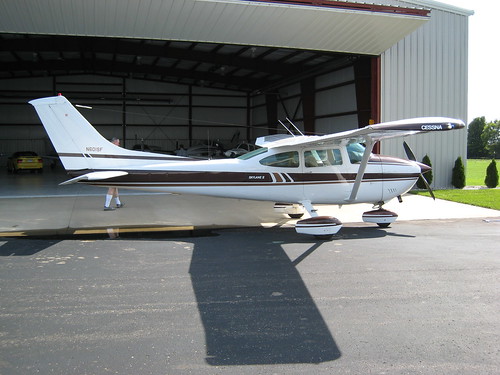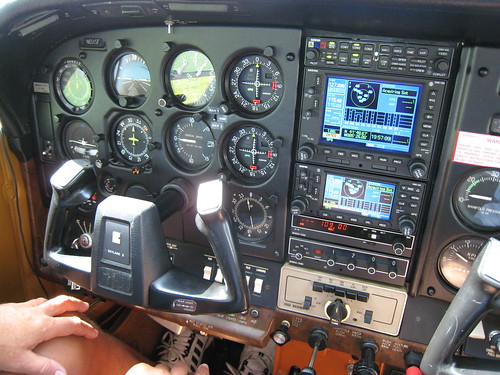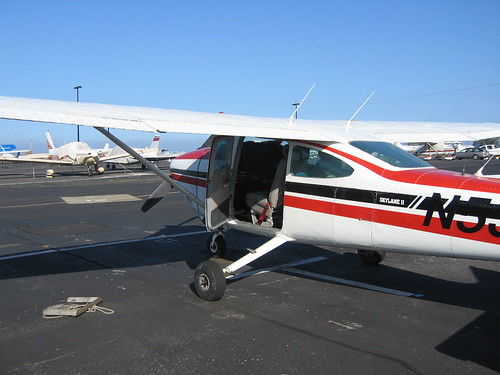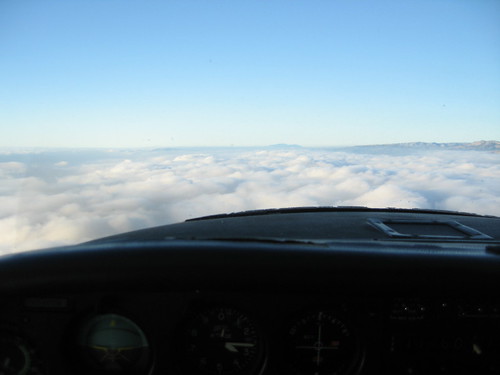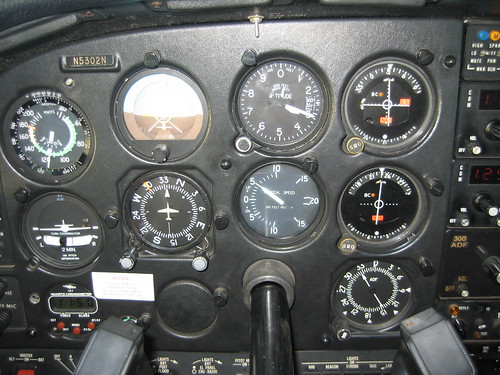A couple months ago, we bought a 1979 Cessna 182Q (N601SF) that's currently sitting in Michigan. It's been having a bit of work and upgrades performed, and that's a good thing on several levels. We've been so busy that I haven't had the time to go pick it up (and by "pick it up" I mean "fly it back to California") or even fly one locally to get the hang of it.
Unlike the Citabria I fly, the Cessna 182 "Skylane" is bigger, faster, and more complicated. It has a 230 horsepower engine, 4 seats, flaps, a constant speed propeller, and a much more populated instrument panel. Oh, and it has the little wheel on the nose, too.
The original plan was for me to fly out with an instructor and bring the airplane back, while getting 182 experience and my insurance requirements along the way--much like I did for bringing Citabria N5156X back to California in April of 2006.
However, scheduling problems have conspired against that, so I went with the backup plan: getting checked out locally in a 182 and taking a more experienced pilot to make the journey with me--someone with an instrument rating, just in case we need it (this time of year, odds are that we will).
Since I have over 100 hours of tailwheel time already, the insurance company only requires that I get 4 hours of dual time (instruction) in a 182 before they're willing to insure me. That shocked me at first, but by the time I had a few hours in the airplane I began to understand why: it's pretty easy to fly.
Overall Checkout
In looking at the local options, I found that Shoreline Flying Club, based at KPAO in Palo Alto, was my best option. They had a 1980 Cessna 182 (N5302N) on the line, have no monthly dues, an no initiation fee. Granted, the avionics are different, but the airplane and engine were virtually identical to the 1979 model that we'd purchased.
I scheduled several hours on both Sunday and Monday of last week to fly with William Hightower. When we first met, I explained my background and experience a bit, and then told him that my main concern was learning how to takeoff and land the 182. I reasoned that I could figure most everything else out along the way.
He agreed and we planned to fly on Sunday from Palo Alto airport down to Hollister airport so that I could get some practice on a big runway at a familiar and relatively quite airport. That'd let me focus on the airplane and not dealing with tons of other planes and/or controllers.
I spent most of the fight down there understanding how to trim the airplane and getting a sense of what it feels/sounds like at various power settings and whatnot. Down at the airport, we shot about seven full stop landings in the light crosswind on runway 31 before returning back to Palo Alto under a 1,500 foot cloud layer.
Much to my surprise, I was already fairly comfortable in the airplane after about 2.4 hours behind the controls.
On Monday we did basically the same thing, but we headed to South County airport instead. There we experimented more with landings in different flap settings--everything from zero flaps to the full 40 degree flaps (that was fun!). I also performed a simulated engine-out landing and a soft field takeoff. On the way home I got to play with the simple auto pilot a bit as well.
We ended the day with another 1.8 hours of time logged, enough to make me and the insurance company comfortable with my ability to keep from doing anything too stupid in the 182.
On both days, we did some other air work on the way to/from our destination. That included turns, stalls, slow flight, and the usual stuff one would expect in a new aircraft checkout.
Here are thoughts on a few specific aspects of the checkout that I was concerned about.
Flaps
For some reason, I figured that flying with flaps would be more complicated that I thought. In reality, however, it was not a big deal at all. In the 182 it seems like flying the takeoff with 20 degrees is almost always ideal, and landing with either 20 or 30 degrees works well unless you're in unusual circumstances.
Beyond the few minutes near the ground, I never had to think about the flaps. I did manage to forget to retract them to extend my glide during a simulated engine-out landing, but that's the only time they managed to surprise me. Given a good checklist for takeoff and landing (which I have), I don't really anticipate any problems.
I must say, landing with FULL FLAPS the first time is quite an experience. :-)
Constant Speed Propeller
My biggest concern was the extra workload associated with having a constant speed propeller. For whatever reason, the various material I'd read beforehand made it all sound far more complicated than what it really is.
The bottom line is that I don't have to think much about touching the prop control until we're safely away from the airport and getting into cruise mode. And then, like the flaps, I don't have to worry about it again (during normal operations) until entering the landing pattern when I'd start to reduce power, slow down, and so on.
Autopilot
Knowing that this particular airplane had mostly original equipment, meant that I could test out the simple Cessna 300A "Navomatic" autopilot. That's exactly what N601SF has too.
On one flight, I set the heading bug on the direction gyro to something about 15 degrees off our current heading made sure that the HDS SEL button was pushed, and turned the autopilot on. As if by magic, the airplane turned to that heading and then flew wings level (minus a small rudder trim problem) on course without me having to touch anything.
That's pretty cool. I can definitely see how this is going to be useful on longer flights now. Even without the altitude hold feature that fancier S-TEC autopilots have, it means you can fly mostly hands-free for a good stretch.
Conclusion
I no longer think the insurance companies are crazy for requiring so little time to fly a Cessna 182. And if you happen to be in the Bay Area looking for a smaller flying club with no dues and a good selection of airplanes, checkout Shoreline Flying Club.
Posted by jzawodn at November 26, 2007 12:53 PM | edit

